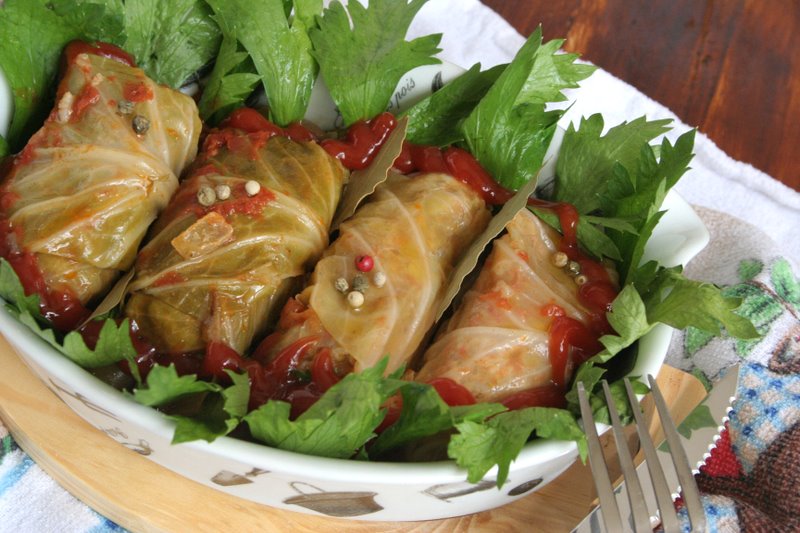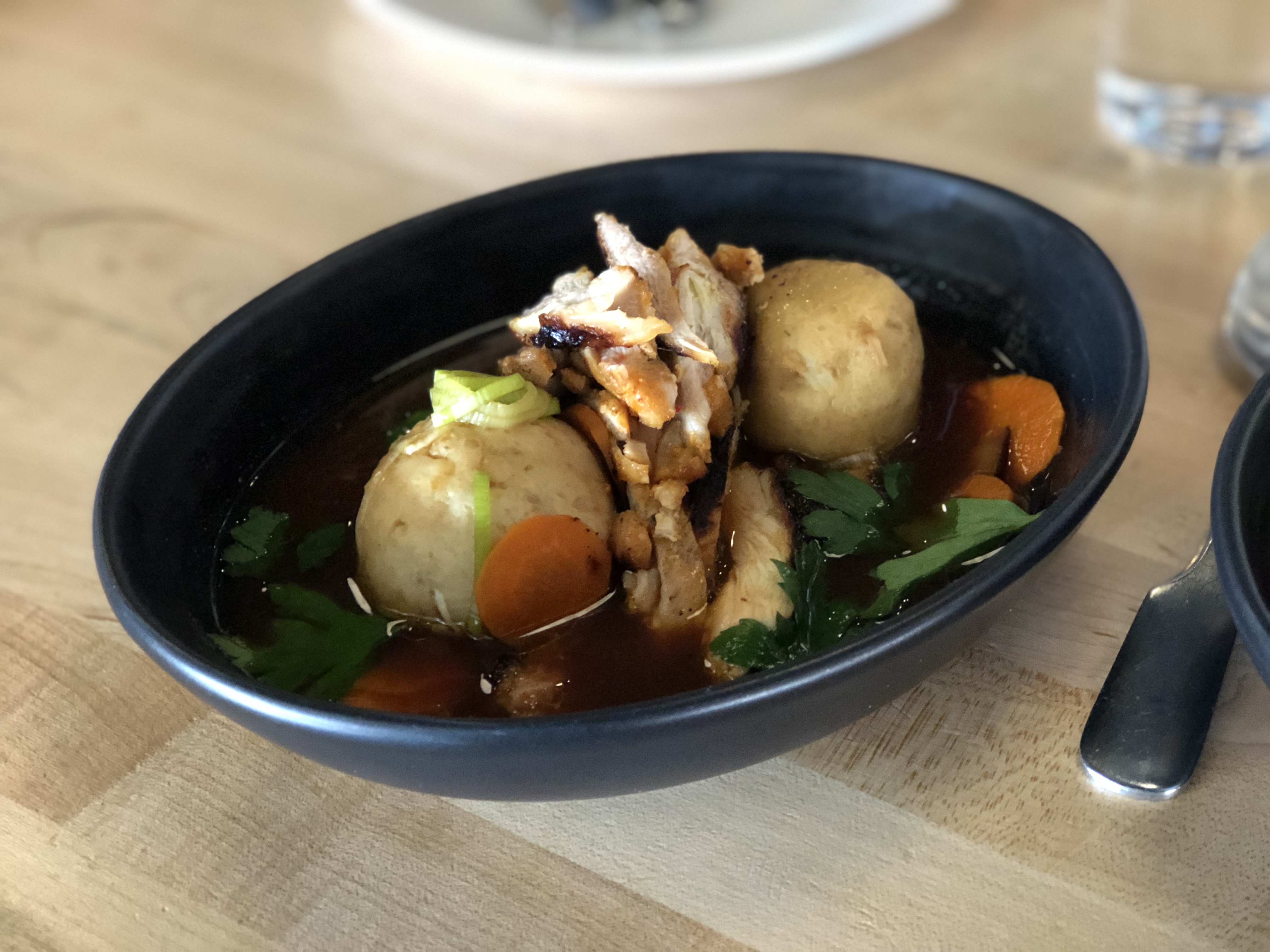|
Holishkes
Holishkes (also holipches or huluptzes or prokes or gefilte kroit) is a traditional Jewish cabbage roll dish. Holishkes are prepared from blanched cabbage leaves wrapped in a parcel-like manner around minced meat and then simmered in tomato sauce. Sometimes rice is added to the meat filling. While the dish is eaten all year round, it is customarily served on Sukkot to symbolize a bountiful harvest, and on Simchat Torah because two stuffed cabbage rolls placed side by side resemble Torah scrolls. History Jews in the Russian Empire and north-eastern Poland adapted holishkes from a dish served by the Slavs while Jews in Hungary and the Balkans learned it from their Slavic and Romanian neighbors (cf. sarma). Eastern European Jews called it "golub" (dove), because the rolled cabbage in sauce resembled a bird in a nest. The spicing varies by community. Hungarian Jews use a dash of marjoram; Syrians add cinnamon; Persians add dill and mint. As meat was expensive, rice was added to exte ... [...More Info...] [...Related Items...] OR: [Wikipedia] [Google] [Baidu] |
Gołąbki
Gołąbki is the Polish name of a dish popular in cuisines of Central Europe, made from boiled cabbage leaves wrapped around a filling of minced pork or beef, chopped onions, and rice or barley. Gołąbki are often served during the Christmas season and on festive occasions such as weddings. They are also a featured dish for family reunions amongst Polish Americans. An alternative to the dish are Jewish holishkes, served on Sukkot and Simchat Torah. Etymology is the plural form of , the diminutive form of ("pidgeon, dove"). Max Vasmer accepts this as the origin of the word, stating that the dish was so named due to similarity in shape. The Polish linguist Marek Stachowski find this theory semanticaly dubious. He instead proposes an Oriental borrowing, pointing out that a similar dish, aside from Eastern Europe, is known in the Levant and Central Asia. He mentions Persian "cabbage" or "cabbage roll" and Old Armenian "cabbage" as possible sources. The word would have la ... [...More Info...] [...Related Items...] OR: [Wikipedia] [Google] [Baidu] |
Cabbage Roll
A cabbage roll is a dish consisting of cooked cabbage leaves wrapped around a variety of fillings. It is common to the cuisines of Central, Northern, Eastern and Southeastern Europe and much of Western Asia, Northern China, as well as parts of North Africa. Meat fillings are traditional in Europe, and include beef, lamb, or pork seasoned with garlic, onion, and spices. Grains such as rice and barley, mushrooms, and vegetables are often included as well. Fermented cabbage leaves are used for wrapping, particularly in southeastern Europe. In Asia, seafoods, tofu, and shiitake mushrooms may also be used. Chinese cabbage is often used as a wrapping. Cabbage leaves are stuffed with the filling which are then baked, simmered, or steamed in a covered pot and generally eaten warm, often accompanied with a sauce. The sauce varies widely by cuisine. In Sweden and Finland, stuffed cabbage is served with lingonberry jam, which is both sweet and tart. In Eastern Europe, tomato-based sau ... [...More Info...] [...Related Items...] OR: [Wikipedia] [Google] [Baidu] |
Syrians
Syrians ( ar, سُورِيُّون, ''Sūriyyīn'') are an Eastern Mediterranean ethnic group indigenous to the Levant. They share common Levantine Semitic roots. The cultural and linguistic heritage of the Syrian people is a blend of both indigenous elements and the foreign cultures that have come to inhabit the region of Syria over the course of thousands of years. The mother tongue of most Syrians is Levantine Arabic, which came to replace the former mother tongue, Aramaic, following the Muslim conquest of the Levant in the 7th century. The conquest led to the establishment of the Caliphate under successive Arab dynasties, who, during the period of the later Abbasid Caliphate, promoted the use of the Arabic language. A minority of Syrians have retained Aramaic which is still spoken in its Eastern and Western dialects. In 2018, the Syrian Arab Republic had an estimated population of 19.5 million, which includes, aside from the aforementioned majority, ethnic minorities such ... [...More Info...] [...Related Items...] OR: [Wikipedia] [Google] [Baidu] |
Ashkenazi Jewish Cuisine
Ashkenazi Jewish cuisine is an assortment of cooking traditions that was developed by the Ashkenazi Jews of Eastern, Central, Western, Northern, and Southern Europe, and their descendants, particularly in the United States and other Western countries. Ashkenazi Jewish foods have frequently been unique to Ashkenazi Jewish communities, and they frequently consist of local ingredients (such as beets, cabbage, and potato), all of which are generally prepared in accordance with the laws of ''kashrut''. Some of these ingredients have not been popular in local or neighbouring non-Jewish communities due to a history of limited interaction between Ashkenazi Jews and non-Jews. The cuisine is largely based on ingredients that were affordable to the historically poor Ashkenazi Jewish community of Europe, and it is frequently composed of ingredients that were readily available and affordable in the regions and communities of Europe in which Ashkenazi Jews lived. Some ingredients were cons ... [...More Info...] [...Related Items...] OR: [Wikipedia] [Google] [Baidu] |
List Of Cabbage Dishes
This is a list of cabbage dishes and foods. Cabbage (''Brassica oleracea'' or variants) is a leafy green or purple biennial plant, grown as an annual vegetable crop for its dense-leaved heads. Cabbage heads generally range from , and can be green, purple and white. Smooth-leafed firm-headed green cabbages are the most common, with smooth-leafed red and crinkle-leafed savoy cabbages of both colors seen more rarely. Cabbages are prepared in many different ways for eating. They can be pickled, fermented for dishes such as sauerkraut, steamed, stewed, sautéed, braised, or eaten raw. Cabbage is a good source of vitamin K, vitamin C and dietary fiber. Contaminated cabbage has been linked to cases of food-borne illness in humans. Cabbage dishes * Bacon and cabbage – traditionally associated with Ireland, the dish consists of unsliced back bacon (although smoked bacon is sometimes used), and it is boiled with cabbage. (Sometimes other vegetables are added such as turnips, onions ... [...More Info...] [...Related Items...] OR: [Wikipedia] [Google] [Baidu] |
Polish Cuisine
Polish cuisine ( pl, kuchnia polska) is a style of cooking and food preparation originating in or widely popular in Poland. Due to Poland's history, Polish cuisine has evolved over the centuries to be very eclectic, and it shares many similarities with other regional cuisines. Polish-styled cooking in other cultures is often referred to as ''à la polonaise''. Polish cuisine is rich in meat, especially pork, chicken and game, in addition to a wide range of vegetables, spices, mushrooms, and herbs. Polish Meals – Polish Food – Polish Cuisine . Retrieved 6 June 2011. It is also characteristic in its use of various kinds of noodles, |
Mentha
''Mentha'' (also known as mint, from Greek , Linear B ''mi-ta'') is a genus of plants in the family Lamiaceae (mint family). The exact distinction between species is unclear; it is estimated that 13 to 24 species exist. Hybridization occurs naturally where some species' ranges overlap. Many hybrids and cultivars are known. The genus has a subcosmopolitan distribution across Europe, Africa - (Southern Africa), Asia, Australia - Oceania, North America and South America. Its species can be found in many environments, but most grow best in wet environments and moist soils. Description Mints are aromatic, almost exclusively perennial herbs. They have wide-spreading underground and overground stolons and erect, square, branched stems. Mints will grow 10–120 cm (4–48 inches) tall and can spread over an indeterminate area. Due to their tendency to spread unchecked, some mints are considered invasive. The leaves are arranged in opposite pairs, from oblong to lanceo ... [...More Info...] [...Related Items...] OR: [Wikipedia] [Google] [Baidu] |
Dill
Dill (''Anethum graveolens'') is an annual herb in the celery family Apiaceae. It is the only species in the genus ''Anethum''. Dill is grown widely in Eurasia, where its leaves and seeds are used as a herb or spice for flavouring food. Growth Dill grows up to , with slender hollow stems and alternate, finely divided, softly delicate leaves long. The ultimate leaf divisions are broad, slightly broader than the similar leaves of fennel, which are threadlike, less than broad, but harder in texture. The flowers are white to yellow, in small umbels diameter. The seeds are long and thick, and straight to slightly curved with a longitudinally ridged surface. Etymology The word ''dill'' and its close relatives are found in most of the Germanic languages; its ultimate origin is unknown. The generic name ''Anethum'' is the Latin form of Greek ἄνῑσον / ἄνησον / ἄνηθον / ἄνητον, which meant both 'dill' and 'anise'. The form ''anīsum'' came to be used f ... [...More Info...] [...Related Items...] OR: [Wikipedia] [Google] [Baidu] |
Persians
The Persians are an Iranian ethnic group who comprise over half of the population of Iran. They share a common cultural system and are native speakers of the Persian language as well as of the languages that are closely related to Persian. The ancient Persians were originally an ancient Iranian people who had migrated to the region of Persis (corresponding to the modern-day Iranian province of Fars) by the 9th century BCE. Together with their compatriot allies, they established and ruled some of the world's most powerful empires that are well-recognized for their massive cultural, political, and social influence, which covered much of the territory and population of the ancient world.. Throughout history, the Persian people have contributed greatly to art and science. Persian literature is one of the world's most prominent literary traditions. In contemporary terminology, people from Afghanistan, Tajikistan, and Uzbekistan who natively speak the Persian language are know ... [...More Info...] [...Related Items...] OR: [Wikipedia] [Google] [Baidu] |
Cinnamon
Cinnamon is a spice obtained from the inner bark of several tree species from the genus '' Cinnamomum''. Cinnamon is used mainly as an aromatic condiment and flavouring additive in a wide variety of cuisines, sweet and savoury dishes, breakfast cereals, snack foods, bagels, teas, and traditional foods. The aroma and flavour of cinnamon derive from its essential oil and principal component, cinnamaldehyde, as well as numerous other constituents including eugenol. Cinnamon is the name for several species of trees and the commercial spice products that some of them produce. All are members of the genus ''Cinnamomum'' in the family Lauraceae. Only a few ''Cinnamomum'' species are grown commercially for spice. '' Cinnamomum verum'' (AKA ''C. zeylanicum''), known as "Ceylon cinnamon" after its origins in Sri Lanka (formerly Ceylon), is considered to be "true cinnamon", but most cinnamon in international commerce is derived from four other species, usually and more correctly refe ... [...More Info...] [...Related Items...] OR: [Wikipedia] [Google] [Baidu] |
Marjoram
Marjoram (; ''Origanum majorana'') is a cold-sensitive perennial herb or undershrub with sweet pine and citrus flavours. In some Middle Eastern countries, marjoram is synonymous with oregano, and there the names sweet marjoram and knotted marjoram are used to distinguish it from other plants of the genus ''Origanum''. It is also called pot marjoram, although this name is also used for other cultivated species of ''Origanum''. History Marjoram is indigenous to Cyprus, the Mediterranean, Turkey, Western Asia, the Arabian Peninsula, and the Levant, and was known to the ancient Greeks and Romans as a symbol of happiness. It may have spread to the British Isles during the Middle Ages. Marjoram was not widely used in the United States until after World War II. The name marjoram ( Old French: ''majorane''; ) does not directly derive from the Latin word (major). Marjoram is related to Samhain, the Celtic pagan holiday that would eventually become Halloween. It has also been used ... [...More Info...] [...Related Items...] OR: [Wikipedia] [Google] [Baidu] |






